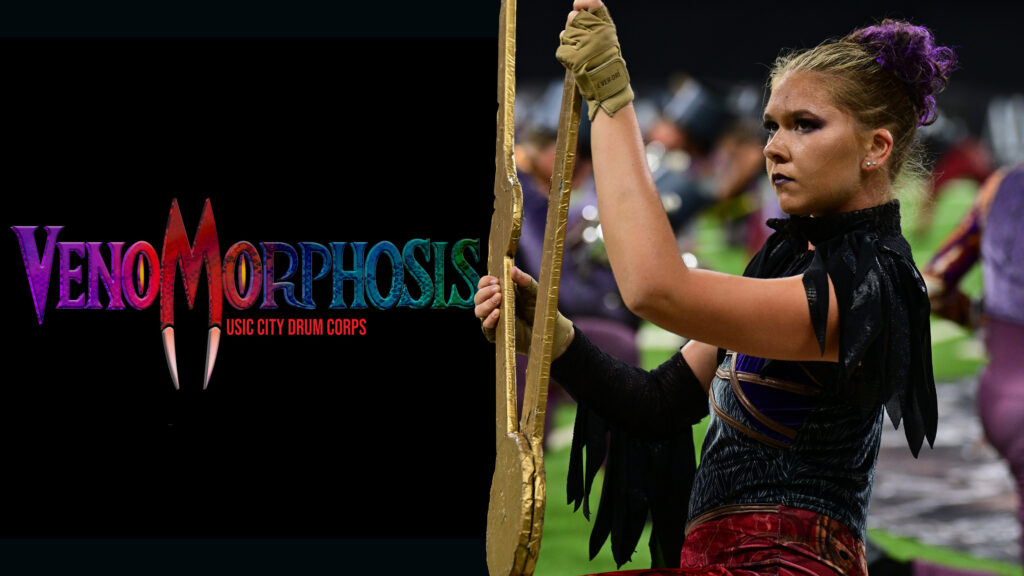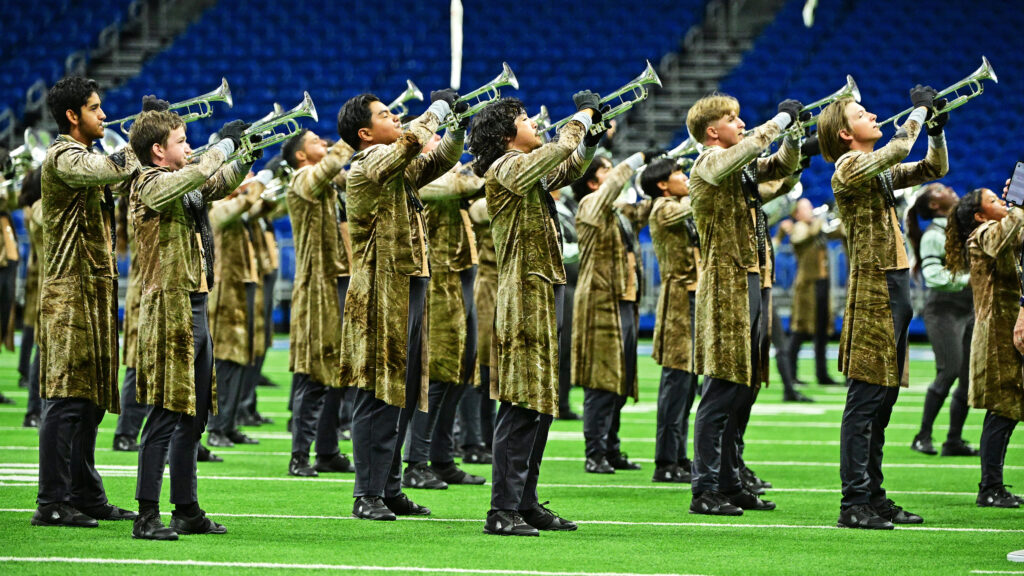The 2014 Drum Corps International World Championship is remembered for the Blue Devils finishing the season undefeated. In the process, the corps broke a nearly decade old scoring record, ending just 0.350 from a perfect score.
The Devils took first in every caption except Percussion, which the corps lost to Santa Clara Vanguard by only 0.15 of a point. Bluecoats finished with the corps’ highest placement ever, passing up the Cadets, who had been second in both Prelims and Semifinals.
Bluecoats’ “Tilt” was performed on a field that was tilted to the side, bordered by an off-kilter perimeter comprised of orange runners. The drill was oriented to the tilt of the runners, meaning lines and blocks were often not parallel to the field’s yard lines.
Carrying the theme through the entire show, the corps’ pre-recorded introduction was audibly “tilted,” as were the sash cummerbunds on the uniforms, and even the drum major stand. Eighteen obtuse scalene triangle ramps, painted white on one side and orange on the other, were continuously maneuvered around the field, constantly changing the visual texture.
All music in the production was written by young American composers who, according to Bluecoats program coordinator Dean Westman, are artists who “view the world from a different angle,” which made the music appropriate to be “tilted.”
Westman continued, “These composers worry not about categories and narrative. They compose music through atmosphere, energy, and sound. They create high voltage minimalism, somber songs and shimmering textures full of electronic color. This new generation of composers redefines music for a 21st Century audience. They give us a glimpse of how modern technology and contemporary sounds blend with the rules and traditions of ‘classical’ music and how that music can cause art to lean forward and create something powerful and new.”
Indeed, modern technology was a highly important component of the show, as the corps’ pioneering use of electronics was extremely effective. Westman had an idea why, which he expressed during the 2014 season: “We have an amazing electronics designer, but the true reason it’s working is that we’re not adding a layer of electronics upon a work that was composed to be acoustic. The majority of the electronics we are using were actually written into the original compositions. Choosing source music that had electronics in the first place makes it translate really well into our idiom.”
The corps played two selections by Tyondai Braxton, an experimental music performer and singer whom some have compared to Frank Zappa. Braxton is a former guitarist, keyboardist, and vocalist for the American prog-rock band Battles, which he co-founded in 2002. He also once played in a trio with Chick Corea and is the son of composer and free jazz woodwind artist Anthony Braxton.
Intrigued by the drum corps activity, and wondering why a corps would be interested in playing his music, Braxton requested recordings of the corps throughout the season in order to follow the Bluecoats’ process. “It’s a surreal experience knowing that the source music composers are listening to the corps,” Westman said.

Westman continued, “These composers worry not about categories and narrative. They compose music through atmosphere, energy, and sound. They create high voltage minimalism, somber songs and shimmering textures full of electronic color. This new generation of composers redefines music for a 21st Century audience. They give us a glimpse of how modern technology and contemporary sounds blend with the rules and traditions of ‘classical’ music and how that music can cause art to lean forward and create something powerful and new.”
Indeed, modern technology was a highly important component of the show, as the corps’ pioneering use of electronics was extremely effective. Westman had an idea why, which he expressed during the 2014 season: “We have an amazing electronics designer, but the true reason it’s working is that we’re not adding a layer of electronics upon a work that was composed to be acoustic. The majority of the electronics we are using were actually written into the original compositions. Choosing source music that had electronics in the first place makes it translate really well into our idiom.”
The corps played two selections by Tyondai Braxton, an experimental music performer and singer whom some have compared to Frank Zappa. Braxton is a former guitarist, keyboardist, and vocalist for the American prog-rock band Battles, which he co-founded in 2002. He also once played in a trio with Chick Corea and is the son of composer and free jazz woodwind artist Anthony Braxton.
Intrigued by the drum corps activity, and wondering why a corps would be interested in playing his music, Braxton requested recordings of the corps throughout the season in order to follow the Bluecoats’ process. “It’s a surreal experience knowing that the source music composers are listening to the corps,” Westman said.

The show’s closer was Braxton’s “Platinum Rows,” also from his “Central Market” album. Braxton says that his influence for the piece included Stravinsky and Brian Eno, the experimental English musician who coined the term, “ambient music,” which is a sort of calming background mood music mostly devoid of melody. Braxton’s work featured dizzying strings and an enthusiastic use of kazoos and explosive guitars. Consider what the music Stravinsky might sound like if the composer were alive today with access to digital technology.
Tubas standing on the ramps played four-part harmony, a most unusual effect. Then came the moment for which everyone in the stands anticapted; the corps’ monstrously popular pitch bend effect. As the horn players got on their knees and leaned back to play a loud chord, they conspicuously removed their horns from their faces and let a synthesizer take over. The horn players bent over further as the synth effect slid ever lower in pitch. Kneeling upright, the horn players went back into playing position for the next chord, then lifted the horns above their heads as the pitch bend rose higher.
The reason the synthesized sounds were so effective was due to the sound originating with the corps itself. The brass section recorded the chords early in the season, which were then sampled and played back in mutated form by the synthesizer—in effect creating a virtual horn line.
At the very end, a horn player set down his instrument, vigorously ran across 20 yards, continued up one of the ramps at full speed and threw himself high off the ramp into the waiting arms of several color guard members, the entire group collapsing to the ground with all energy expended.
For this week only, you can save on the DVD or Blu-ray set that contains this complete Bluecoats performance, along with all finalists from the 2014 DCI World Championship.
Buy the 2014 World Championship Blu-ray set.
Buy the 2014 World Championship DVD set.
(Either available for 30% off for a limited time only.)
2014 Overview

Michael Boo was a member of the Cavaliers from 1975-1977. He has written about the drum corps activity for more than a quarter century and serves as a staff writer for various Drum Corps International projects. Boo has written for numerous other publications and has published an honors-winning book on the history of figure skating. As an accomplished composer, Boo holds a bachelor's degree in music education and a master's degree in music theory and composition. He resides in Chesterton, Indiana.





